Hair loss prevention is a common concern, especially for those in the transgender community taking estradiol, testosterone, or other medications for gender-affirming hormone therapy (GAHT). If you are on GAHT, you may also experience changes in your hair growth patterns. Understanding the impact of GAHT on hair loss and exploring hair restoration options can help you make informed decisions about your gender journey. In addition to offering hair restoration treatment options, we will review the effects of gender-affirming hormone therapy on hair loss, the benefits of hair loss medication, and practical tips for preventing hair loss.
Table of Contents
Understanding Hair Loss In The Context Of Gender Transition
Navigating the journey of gender transition brings about various changes and challenges, one of which may include the experience of hair loss. This issue, while common in the general population, carries unique implications for us in the transgender and nonbinary community. Hair is a big deal and deeply touches aspects of our gender identity and self-perception.
Several factors contribute to hair loss during gender transition. Gender-affirming hormone therapy (GAHT) brings about hormonal changes that are often eagerly anticipated. While you may welcome most of these chances with open arms, there can also be unexpected outcomes, such as hair loss or changes in hair texture and density. Genetics also plays a pivotal role in hair loss among transgender individuals undergoing GAHT. Just as in the cisgender population, genes inherited from one’s parents can influence the likelihood and pattern of hair loss. This means that for some, regardless of hormone therapy, hair loss may be an inevitable part of their transition journey due to their genetic predisposition.
Stress, a common companion during gender transition, can exacerbate hair loss. Stress associated with transitioning can come from many places, such as societal pressures and the challenges of aligning one’s physical appearance with one’s gender identity. This stress can contribute to conditions such as telogen effluvium, where stress pushes hair follicles into a resting phase, resulting in hair shedding. This is why stress management is so important for addressing hair loss. Engaging in regular physical activity, mindfulness practices, or seeking professional support can help mitigate stress’s impact on the body and, by extension, hair health.
Acknowledging the physical changes that occur with GAHT while also considering genetic, psychological, and health-related factors provides a holistic perspective for managing expectations and exploring the most suitable hair restoration strategies. Conditions such as alopecia areata, thyroid disorders, and nutrient deficiencies, which can be more prevalent in individuals undergoing significant stress or hormonal changes, may play a role in hair loss. If you are concerned that you may be experiencing these conditions, we strongly suggest you seek out care from your primary care provider for further evaluation.
The Impact Of Gender-Affirming Hormone Therapy On Hair Growth And Loss
Testosterone, when introduced into the body of someone who was assigned female at birth (AFAB), can lead to changes typically associated with masculinization. This includes an increase in facial and body hair, which many may find affirming of their gender identity. However, testosterone can also expedite male pattern baldness, especially in individuals with a genetic predisposition to this type of hair loss. The hormone can cause the hair follicles to shrink, leading to the thinning of hair on the scalp and eventually resulting in hair loss.
On the other hand, estradiol can have protective effects against male pattern baldness. Estradiol can promote a fuller head of hair by extending the growth phase of the hair cycle, which can increase scalp hair density. However, it’s important to note that while estradiol can counteract some forms of hair loss, its effects on hair growth are not universally experienced and can vary widely based on individual genetic factors and other conditions that might affect hair health.
Moreover, the impact of anti-androgens, which may be used alongside estradiol in transfeminine hormone therapy, deserves mention. These medications, such as spironolactone, work by blocking the effects of testosterone, including its role in hair loss. For many transfeminine individuals, the use of anti-androgens can be a critical component in not only mitigating unwanted masculinizing effects but also in promoting the retention and health of scalp hair.
It is also essential to understand that the journey with GAHT is highly individual, with hair growth and loss outcomes differing greatly from one person to another. Factors such as the dosage and duration of hormone therapy, age at the start of therapy, and individual health conditions all play a role. This is why working with healthcare providers familiar with transgender health (like Plume!), is crucial for addressing the specific needs and concerns related to hair growth and loss during hormone therapy.
Hair Restoration Procedures For Transgender Folks
Fortunately, there are several hair restoration options available that cater to the unique needs of the transgender community, providing pathways to not only restore hair but also bolster confidence in one’s gender expression.
One effective method of hair restoration is hair transplant surgery. This procedure involves relocating hair follicles from denser areas of the scalp or other body parts to the thinning or balding regions. This option can offer permanent and natural-looking results. However, it’s important to consult with a surgeon who is experienced in working with transgender individuals to ensure the hairline’s shape and the placement of grafts are aligned with the patient’s transition goals.
Scalp micropigmentation is another technique that offers a non-surgical alternative. This method involves tattooing tiny, hair-like dots onto the scalp to mimic the appearance of a shadow, creating the illusion of a fuller head of hair. It can be particularly beneficial for those with extensive hair loss or those looking for a low-maintenance solution.
Laser hair therapy is yet another option. It utilizes low-level laser light to encourage hair growth by stimulating cellular activity in the follicles. This method is painless and can be used together with other treatments. However, individuals should seek devices specifically cleared by the FDA for safety and efficacy.
Before embarking on any hair restoration treatment, it is crucial to consult with healthcare providers knowledgeable in transgender health. They can offer guidance tailored to individual health profiles, hormone therapy regimens, and specific hair restoration goals. Such a personalized approach ensures that any chosen method aligns well with ongoing gender-affirming hormone therapy and the overall transition journey, supporting not only the growth of hair but also the flourishing of one’s true self.
Benefits Of Hair Loss Medication For Trans People
More accessible and affordable options that provide a non-invasive approach to hair restoration are topical treatments, such as minoxidil. Minoxidil can be applied directly to the scalp to stimulate hair growth and is suitable for both transmasculine and transfeminine individuals. It is available over the counter, making it an accessible option, although patience is required, as it may take several months to see noticeable results. In addition, some patients can safely take minoxidil by mouth. Your provider can discuss whether this is right for you.
Finasteride, a medication that blocks the action of an enzyme responsible for converting testosterone to dihydrotestosterone (DHT), is crucial in mitigating hair thinning and loss. DHT is a key contributor to male pattern baldness, and by inhibiting its production, finasteride can prevent further hair loss, offering a sense of control and reassurance during a period of profound personal change. This mechanism of action does more than preserve hair; it can profoundly impact an individual’s confidence and comfort with their appearance.
Similarly, spironolactone serves a dual purpose. Primarily used as an anti-androgen in the context of hormone therapy, it also has the potential to curb hair loss. By reducing the levels of androgens in the body, which are involved in the development of male-pattern hair loss, spironolactone can help maintain the density and health of scalp hair. Its use reflects the interconnected nature of transition-related healthcare, where treatments often serve multiple roles. Your treatments can contribute to both your mental and physical well-being.
These medications also impact skin health, an aspect of self-care linked to one’s self-image and presentation. By modulating hormone levels, finasteride and spironolactone can reduce acne outbreaks, a common side effect of testosterone therapy. Clearer skin can significantly impact an individual’s quality of life, enhancing their social interactions and internal sense of self-worth.

Practical Tips for Hair Loss Prevention
Navigating hair loss prevention requires a holistic approach, focusing on external and internal health practices. For transgender individuals, especially those undergoing gender-affirming hormone therapy (GAHT), incorporating simple yet effective strategies into daily routines can make a significant difference in maintaining hair health and minimizing loss. We advise to be cautious with hair care and styling habits, such as:
- Opting for gentle, sulfate-free shampoos and conditioners that nurture the scalp without stripping it of natural oils.
- Minimizing the use of heat styling tools and harsh chemical treatments. These can weaken hair strands and contribute to breakage.
- When styling, avoid tight hairstyles that place excessive tension on the hair follicles, as this can lead to traction alopecia over time.
- Protecting your scalp from environmental stressors such as UV radiation and pollution. Wearing hats or using hair products with built-in sun protection can shield the scalp and hair from damage.
- Ensuring your scalp is clean and hydrated. This promotes a healthy environment for hair growth.
By combining these practical tips with professional advice, you can create a comprehensive hair care regimen that supports not just hair health but also your well-being and confidence during your transition.
As you navigate the multifaceted journey of gender transition, understanding and addressing hair loss can be a crucial aspect of affirming your identity and bolstering your confidence. Whether you’re considering hair restoration procedures, exploring hair loss medication, or implementing practical prevention tips, it’s essential to seek guidance from healthcare providers who understand the unique needs of the transgender community. At Plume, we offer affordable hair restoration treatments tailored to support your transition journey and empower you to embrace your true self fully. Learn more about how to get started with us today and how we can support you on your path to hair restoration and self-affirmation.



